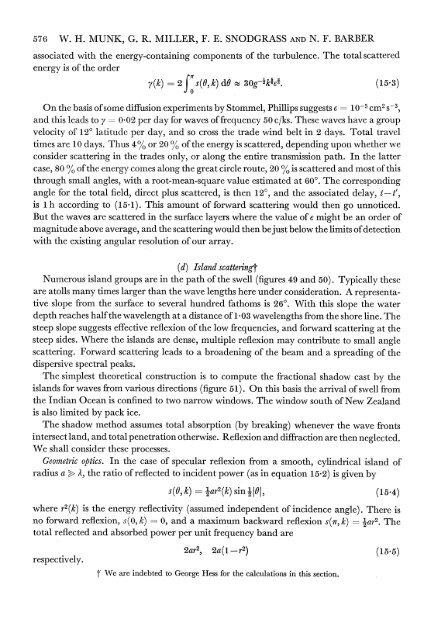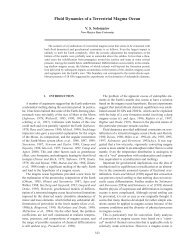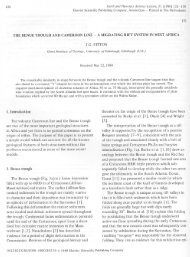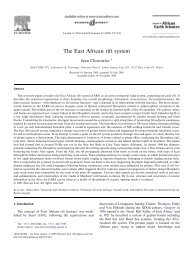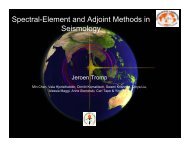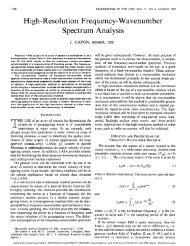Directional Recording of Swell from Distant Storms - Department of ...
Directional Recording of Swell from Distant Storms - Department of ...
Directional Recording of Swell from Distant Storms - Department of ...
Create successful ePaper yourself
Turn your PDF publications into a flip-book with our unique Google optimized e-Paper software.
576 W. H. MUNK, G. R. MILLER, F. E. SNODGRASS AND N. F. BARBERassociated with the energy-containing components <strong>of</strong> the turbulence. The total scatteredenergy is <strong>of</strong> the ordery(k) = 2 f s(8, k) dO 30g-1k0J. (15.3)On the basis <strong>of</strong> some diffusion experiments by Stommel, Phillips suggests e -0-5 cm2 S-3,and this leads to y = 0-O2 per day for waves <strong>of</strong> frequency 50 c/ks. These waves have a groupvelocity <strong>of</strong> 120 latitude per day, and so cross the trade wind belt in 2 days. Total traveltimes are 10 days. Thus 400 or 200 <strong>of</strong> the energy is scattered, depending upon whether weconsider scattering in the trades only, or along the entire transmission path. In the lattercase, 80 % <strong>of</strong> the energy comes along the great circle route, 20 % is scattered and most <strong>of</strong> thisthrough small angles, with a root-mean-square value estimated at 60?. The correspondingangle for the total field, direct plus scattered, is then 12?, and the associated delay, t- t',is 1 h according to (15.1). This amount <strong>of</strong> forward scattering would then go unnoticed.But the waves are scattered in the surface layers where the value <strong>of</strong> 6 might be an order <strong>of</strong>magnitude above average, and the scattering would then bejust below the limits <strong>of</strong> detectionwith the existing angular resolution <strong>of</strong> our array.(d) Island scatteringtNumerous island groups are in the path <strong>of</strong> the swell (figures 49 and 50). Typically theseare atolls many times larger than the wave lengths here under consideration. A representativeslope <strong>from</strong> the surface to several hundred fathoms is 260. With this slope the waterdepth reaches half the wavelength at a distance <strong>of</strong> 1P03 wavelengths <strong>from</strong> the shore line. Thesteep slope suggests effective reflexion <strong>of</strong> the low frequencies, and forward scattering at thesteep sides. Where the islands are dense, multiple reflexion may contribute to small anglescattering. Forward scattering leads to a broadening <strong>of</strong> the beam and a spreading <strong>of</strong> thedispersive spectral peaks.The simplest theoretical construction is to compute the fractional shadow cast by theislands for waves <strong>from</strong> various directions (figure 51). On this basis the arrival <strong>of</strong> swell <strong>from</strong>the Indian Ocean is confined to two narrow windows. The window south <strong>of</strong> New Zealandis also limited by pack ice.The shadow method assumes total absorption (by breaking) whenever the wave frontsintersect land, and total penetration otherwise. Reflexion and diffraction are then neglected.We shall consider these processes.Geometric optics. In the case <strong>of</strong> specular reflexion <strong>from</strong> a smooth, cylindrical island <strong>of</strong>radius a > A, the ratio <strong>of</strong> reflected to incident power (as in equation 15.2) is given bys(O, k) == ar2(k) sin 101, (15.4)where r2(k) is the energy reflectivity (assumed independent <strong>of</strong> incidence angle). There isno forward reflexion, s(0, k) 0, and a maximum backward reflexion s(ir, k) =-ar2. Thetotal reflected and absorbed power per unit frequency band arerespectively. 2ar2, 2a(1-r2) (15.5)t We are indebted to George Hess for the calculations in this section.


